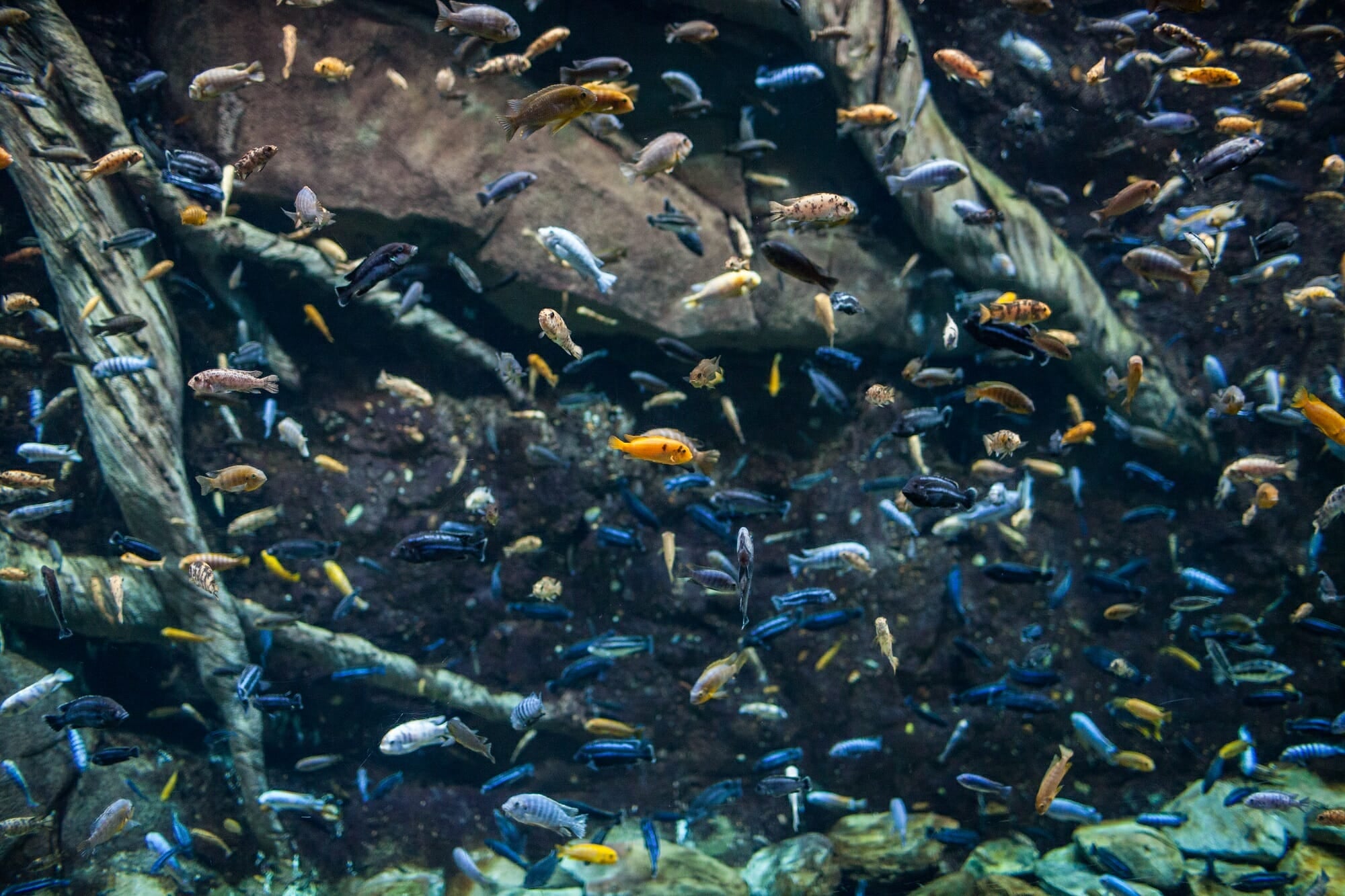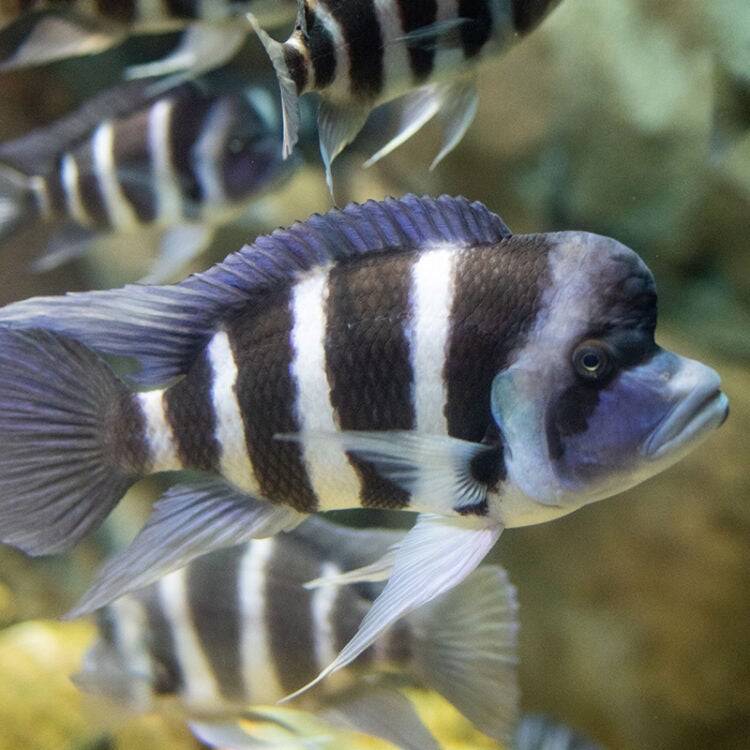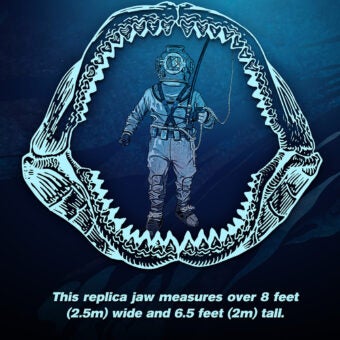-
Size
1 inch (2.5 cm) to 3 feet (1 m) -
Diet
Phytoplankton, zooplankton, benthic algae, plants, insects, molluscs, fish eggs and larvae -
Range
Africa, India, South America -
Habitat
Aquatic habits ranging from open water to shallow areas in lakes, rivers, streams, and swamps
Physical Characteristics
- Cichlids exhibit a wide range of body shapes. The most common form is ovate and somewhat laterally compressed, but some species are strongly compressed or cylindrical and elongated.
- The size of individuals varies by species and ranges from about one inch (2.5 cm) to three feet (1 m).
- This family is noted for the profusion of bright colors and color patterns found among different species. Just about every color found in fish anywhere can also be found in some species of cichlids.
Animal Fun Fact
Many African cichlids are mouth brooders. The female holds the fertilized eggs and the developing young in her mouth until her mouth is no longer large enough to accommodate them. She does not eat during this time.
Diet / Feeding
- Cichlids exhibit a great diversity of feeding adaptations and food types: phytoplankton, zooplankton, soft bottom deposits, benthic algae, higher plants, insects, mollusks, fish scales and fins, fish eggs and larvae, among others.
- Specialization of the jaws and dentition have allowed cichlid species to occupy a wide range of habitats and feed on a diversity of food types.
Range / Habitat
- The cichlids comprise a large family of freshwater fishes that live in tropical and subtropical waters of Africa, Central and South America, as well as parts of Jordan, Iran, India and Sri Lanka.
- Most cichlid species are found in three large lakes in East Africa: Lake Malawi, Lake Victoria and Lake Tanganyika. Lake Malawi alone contains more than 500 species.
- Scientists estimate that there are at least 1,350 species worldwide, and possibly hundreds more new species yet to be described.
- Cichlids occupy a wide range of aquatic habitats: from open water to shallow areas in lakes, rivers, streams and swamps; also mud, sand, rock or vegetated bottoms; and where water temperatures are greater than about 68 degrees F (20 degrees C).
Reproduction & Growth
- Many African cichlids are mouth brooders. The female holds the fertilized eggs and the developing young in her mouth until her mouth is no longer large enough to accommodate them. She does not eat during this time.
- Other species lay their eggs in a prepared area on the bottom and guard and maintain the eggs and for up to three months. Most such “substratum spawners” are found in Central and South America.
- Many species have elaborate and complex breeding behavior. Some cichlid males build elaborate platforms or “castles” of sand (as much as four feet high by seven feet wide!) to attract females. The males of other species use intense coloration in their courting.
Conservation Status
- Some species of cichlids have been eliminated from African lakes due to human activities (see below). Other species in these same areas are threatened.
- Many cichlid species have been introduced to waters outside their native range. These invasive species often have a negative impact on native animals and ecosystems.
Additional Information
- The correct pronunciation of cichlid is “sick-lid.”
- Well-known cichlids include food and sport fish, such as tilapia, and popular aquarium species, such as freshwater angelfish, oscars and discus.
- Since the 19th century, the cichlids in Lake Malawi have been the subject of investigations by scientists studying the process of how different species evolve.
- The great diversity of feeding adaptations among cichlids includes species that mimic the color patterns of their prey which allows them to closely approach individuals to nip off scales and bits of fins.
- Another feeding adaptation involves a cichlid species that falls to the bottom and lies motionless. Its color pattern resembles a rotting corpse that attracts scavenger fish which quickly become its prey.
- Cichlids in African lakes are being seriously impacted by human activities. Unwise agricultural practices and deforestation have resulted in increased turbidity that has interfered with the spawning of many cichlid species. Overfishing has also dangerously reduced some populations.
- The introduction of the Nile perch, a voracious predator, has resulted in the elimination of some cichlid species from African lakes and the collapse of local artisan fisheries based on these species.
- The elimination of some cichlid species from Lake Malawi has resulted in serious health problems for humans. Cases of schistosomiasis, caused by a parasitic worm, have increased dramatically along the shores of the lake because of the proliferation of snails that act as an intermediary host for the parasite. The snail-eating cichlids that kept the snail populations under control are gone, so the populations of the parasite have grown largely unchecked.







